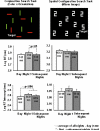Acute sleep deprivation and circadian misalignment associated with transition onto the first night of work impairs visual selective attention
- PMID: 18043740
- PMCID: PMC2077929
- DOI: 10.1371/journal.pone.0001233
Acute sleep deprivation and circadian misalignment associated with transition onto the first night of work impairs visual selective attention
Abstract
Background: Overnight operations pose a challenge because our circadian biology promotes sleepiness and dissipates wakefulness at night. Since the circadian effect on cognitive functions magnifies with increasing sleep pressure, cognitive deficits associated with night work are likely to be most acute with extended wakefulness, such as during the transition from a day shift to night shift.
Methodology/principal findings: To test this hypothesis we measured selective attention (with visual search), vigilance (with Psychomotor Vigilance Task [PVT]) and alertness (with a visual analog scale) in a shift work simulation protocol, which included four day shifts followed by three night shifts. There was a nocturnal decline in cognitive processes, some of which were most pronounced on the first night shift. The nighttime decrease in visual search sensitivity was most pronounced on the first night compared with subsequent nights (p = .04), and this was accompanied by a trend towards selective attention becoming 'fast and sloppy'. The nighttime increase in attentional lapses on the PVT was significantly greater on the first night compared to subsequent nights (p<.05) indicating an impaired ability to sustain focus. The nighttime decrease in subjective alertness was also greatest on the first night compared with subsequent nights (p<.05).
Conclusions/significance: These nocturnal deficits in attention and alertness offer some insight into why occupational errors, accidents, and injuries are pronounced during night work compared to day work. Examination of the nighttime vulnerabilities underlying the deployment of attention can be informative for the design of optimal work schedules and the implementation of effective countermeasures for performance deficits during night work.
Conflict of interest statement
Figures



References
-
- Czeisler CA, Dijk DJ. Use of bright light to treat maladaption to night shift work and circadian rhythm sleep disorders. J Sleep Res. 1995;4:70–73. - PubMed
-
- Horowitz TS, Cade BE, Wolfe JM, Czeisler CA. Efficacy of bright light and sleep/darkness scheduling in alleviating circadian maladaptation to night work. Am J Physiol Endocrinol Metab. 2001;281:E384–E391. - PubMed
-
- Dijk DJ, Duffy JF, Czeisler CA. Circadian and sleep/wake dependent aspects of subjective alertness and cognitive performance. J Sleep Res. 1992;1:112–117. - PubMed
-
- Jewett ME, Kronauer RE. Interactive mathematical models of subjective alertness and cognitive throughput in humans. J Biol Rhythms. 1999;14:588–597. - PubMed
-
- Barger LK, Cade BE, Ayas NT, Cronin JW, Rosner B, et al. Extended work shifts and the risk of motor vehicle crashes among interns. N Engl J Med. 2005;352:125–134. - PubMed
Publication types
MeSH terms
Grants and funding
LinkOut - more resources
Full Text Sources
Other Literature Sources
Medical

